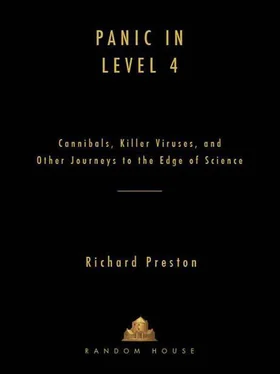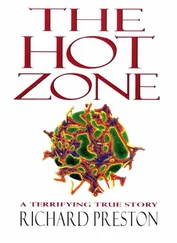I called Michael Morgan, at the Wellcome Trust, to see what he had to say about this. “In hindsight, it is easy to ascribe to us Machiavellian powers that the prince would have been proud of,” he said dryly. “As for the allegation that I’m a bastard, I can easily disprove it using the technology of the Human Genome Project.”
* * *
“ONE OF THE THINGS I really like about Craig Venter is that he almost totally lacks tact,” one of his collaborators, a genomic scientist from U.C. Berkeley, Gerald Rubin, told me. “If he thinks you are an idiot, he will say so. I find that way of dealing very enjoyable. Craig is like somebody who’s using the wrong fork at a fancy dinner. He’ll tell you what he thinks of the food, but he won’t even think about what fork he’s using. It was a great collaboration.”
John Sulston, the head of the Sanger Centre, told the BBC that he felt Celera planned to try to get a monopoly on the human DNA. “The emerging truth is absolutely extraordinary,” Sulston said. “They really do intend to establish a complete monopoly position on the human genome for a period of at least five years.” He added, “It’s something of a con job.”
“Sulston essentially called us a fraud. It’s like he’s been bit by a rabid animal,” Venter fumed.
“It’s puzzling. To me, the whole fight defies rational analysis,” Nobel laureate Hamilton Smith said to me, shortly after his net worth had cratered in Celera’s mud slide. (He had continued to drive his ’83 Marquis, so his lifestyle had not been much affected.) “But the publicly funded labs are angry for reasons I can partly understand,” Smith went on. “We took it away from them. We took the big prize away from them, when they thought they would be the team that would do the whole human genome and go down in history. Pure and simple, they hate us.”
* * *
AS FOR THE SCIENCE, most biologists seemed enthralled with the sight of the human DNA being decoded and revealed. They felt that a great door was opening and light was shining deep into nature, suggesting the presence of rooms upon rooms that had never been seen before. There was also a clear sense that the door would not have been opened so soon if Craig Venter and Celera had not given it a swift kick.
“We can thank Venter in retrospect,” James Watson said, leaning back and smiling and squinting at the ceiling. “I was worried he could do it, and that would stop public funding of the Human Genome Project…but if an earthquake suddenly rattled through Rockville and destroyed Celera’s computers, it wouldn’t make much difference….” His voice trailed off. He stood up and offered me the door.
Eric Lander, who said he liked Craig Venter personally, told me, “Having the human genome is like having a Landsat map of the earth, compared to a world where the map tapers off into the unknown with the words ‘There be dragons.’ It’s as different a view of human biology as a map of the earth in the fourteen hundreds was compared to a view from space today.” As for the war between Celera and the Human Genome Project, he said it was silly. “At a certain level, it was just boys behaving badly. It happened to be the most important project in science of our time, and it had all the character of a school-yard brawl.”
* * *
ON FEBRUARY 16, 2001, close to three billion letters of the human DNA in their roughly proper order were published by Craig Venter (along with two hundred coauthors) in Science magazine, under the title “The Sequence of the Human Genome.” It was a very good draft of the human genome, but it was not finished or fully accurate. That same week, the Human Genome Project published its own draft of the human genome in Nature. Taken together, these publications represented one of the monumental achievements of the twenty-first century. The implications would be with us for the rest our lives, the rest of our grandchildrens’ lives, and their grandchildrens’ lives. “Humanity has been given a great gift,” declared an editorial in Science. “This stunning achievement has been portrayed—often unfairly—as a competition between two ventures, one public and one private. That characterization detracts from the awesome accomplishment unveiled this week.”
Norton Zinder, Watson’s friend, who had feared that he would die before he saw the human genome, said that he felt marvelous. “I made it. Now I’ve gotta stay alive for four more years, or I won’t get all my options in Celera.” Zinder was convinced that Celera’s stock would rise again. (It has not recovered, so far.)
Norton Zinder was a vigorous-seeming older man. As he spoke, he was sprawled in a chair in his office overlooking the East River, gesturing with both hands raised. He shifted gears and began to look into the future. “This is the beginning of the beginning,” he said. “The human genome alone doesn’t tell you crap. This is like Vesalius. Vesalius did the first human anatomy.” Vesalius published his work in 1543, an anatomy based on his dissections of cadavers. “Before Vesalius,” Zinder went on, “people didn’t even know they had hearts and lungs. With the human genome, we finally know what’s there, but we still have to figure out how it all works. Having the human genome is like having a copy of the Talmud but not knowing how to read Aramaic.”
* * *
CRAIG VENTER ended up getting fired from Celera. The man who fired him was Tony L. White, the chief executive of Celera’s parent company (which had been renamed Applera). Tony White had been Craig Venter’s boss during the time Venter worked at Celera—even though Venter was the president of Celera, Applera owned Celera, and so was in control. It seemed that Craig Venter’s business model just wasn’t working out. Venter had figured that Celera would sell information about the human genome to subscribers, who would want to pay money for it. But not enough customers wanted to pay for it.
The problem for Celera was that the Human Genome Project kept on churning out human DNA code and, with taxpayer money, published an increasingly accurate sequence of the letters in the human DNA—published it all for free on the Internet, available to anybody at no cost. Celera couldn’t compete.
Craig Venter lost his job at the moment when Celera’s stock was already crashing, and his firing from Celera caused the stock go into free fall, headed for near zero, it seemed. Venter had to sell all of his shares in Celera upon his exit from the company, and he sold them at the very bottom. He ended up walking away with about one million dollars in his pocket after his adventure with Celera. “I made a million dollars the hard way,” he remarked. “I started with a billion dollars and lost it.”
* * *
AFTER HE LEFT CELERA, Craig Venter went sailing. He still had some assets left, including shares in a company called Diversa, which he had cofounded years earlier. He had also sold Sorcerer (the yacht in which he’d won the Transatlantic Challenge) and he had gotten a few million dollars from that. He took some of the money and bought a used sailing yacht, a ninety-four-foot sloop, named it Sorcerer II, and outfitted it as a marine research vessel. He raised federal and private funding, hired a crew, and went on a voyage to circumnavigate the earth, following the idea of the HMS Challenger expedition of the 1870s, when the British sailing ship went on the first oceanographic expedition to explore the depths of the earth’s oceans. “I was telling people that all I hoped to get out of this deal was a bigger yacht,” he said.
The Sorcerer II sailed thirty-three thousand miles. Every two hundred miles, Venter and his colleagues stopped the boat and took samples of seawater. These bottles of water were sent back to the laboratory of a nonprofit foundation called the J. Craig Venter Institute, in Rockville, which Venter had established and ran.
Читать дальше








![Shin_Stark - В подземелье я пойду, там свой level подниму X [СИ]](/books/384602/shin-stark-v-podzemele-ya-pojdu-tam-svoj-level-po-thumb.webp)



